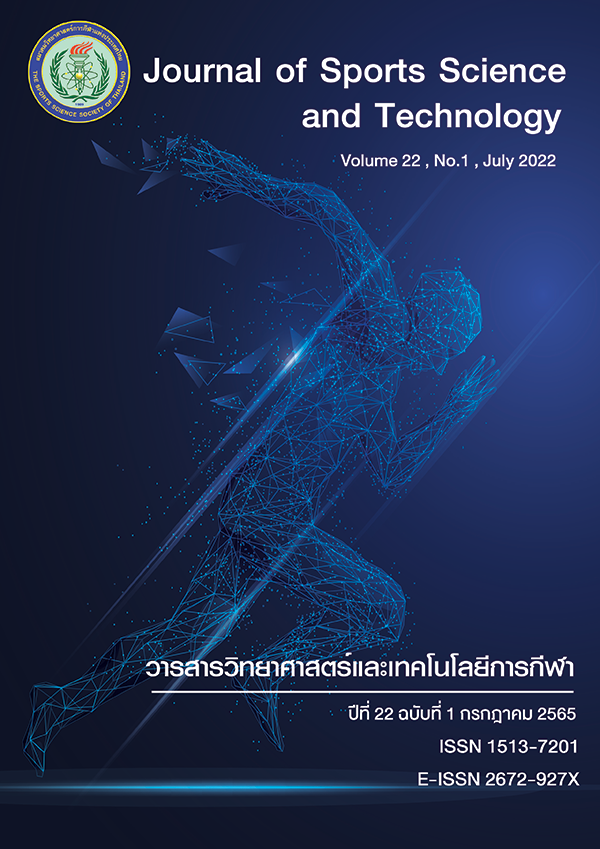INVESTIGATING THE CHANGE IN 3-DIMENSIONAL KNEE AND PELVIC ANGLES DURING 30-MIN TREADMILL RUNNING IN RECREATIONAL RUNNERS: A PRELIMINARY STUDY
DOI:
https://doi.org/10.14456/jsst.2022.3Keywords:
Locomotion, Lower limb kinematics, Running analysis, Spatio-temporal analysisAbstract
This study aimed to investigate changes in knee and pelvic angles during 30-min treadmill running. Eight
recreational runners ran on a treadmill at a speed equivalent to 70% of VO2peak for 30 minutes while simultaneous
3-dimensional motion data of the lower extremities were collected using a lower limb and trunk marker model and
8 optoelectronic cameras. Knee and pelvic angles at initial contact (IC) and toe-off (TO) during the 1st and 30th
min of 5 running gait cycles were analyzed and a paired samples t-test was used to evaluate differences between
two-time points. The results showed no significant differences in 3-dimensional motion knee or pelvic (all P >0.05)
angles between the first and last minute of running. There were also no differences in left and right leg step and
stride length at IC and TO (all P >0.05). It is concluded that knee and pelvic angles do not change over the course
of a 30-min treadmill run. For the pratical implication, the runners could maintain the running pattern consistency
in lower limb kinematics when training 30-minutes run on treadmill.
treadmill.
(Journal of Sports Science and Technology 2022; 22 (1): 37-48)
(Received: 23 January 2022, Revised: 9 March 2022, Accepted: 24 March 2022)
KEYWORDS: Locomotion/ Lower limb kinematics/ Running analysis/ Spatio-temporal analysis
Corresponding author:Parunchaya JAMKRAJANG
College of Sports Science and Technology, Mahidol University, THAILAND
E-mail: parunchaya.jam@mahidol.edu
References
van Middelkoop M, Kolkman J, van Ochten J, et al. Prevalence and incidence of lower extremity injuries in male marathon runners. Scand J Med Sci Sports. 2008;18(2):140-4.
Bridgman CF. Biomechanical evaluation of distance running during training and competition. University of Salford (United Kingdom). 2015.
Dugan SA, Bhat KP. Biomechanics and analysis of running gait. Rehabil Clin N Am. 2005;16(3):603-621.
Kapri E, Mehta M, Singh K. Biomechanics of running: An overview on gait cycle. Int. J. Phys. Educ. Fit. Sports. 2021;10(3):1-9.
van Oeveren BT, de Ruiter CJ, Beek PJ, van Dieën JH. The biomechanics of running and running styles: a synthesis. Sports Biomech. 2021;1-39.
Novacheck TF. The biomechanics of running. Gait Posture. 1998;7(1):77-95.
Saunders, SW, Schache A, Rath D, Hodges PW. Changes in three dimensional lumbo-pelvic kinematics and trunk muscle activity with speed and mode of locomotion. Clin Biomech. 2005;20(8):784-93.
Derrick TR, Dereu DA, McLean SP. Impacts and kinematic adjustments during an exhaustive run. Med Sci Sports Exerc. 2002;34(6):998-1002.
Devita P, Fellin RE, Seay JF, Ip E, et al. The relationships between age and running biomechanics. Med Sci Sports Exerc. 2016;48(1):98-106.
Silvernail JF, Boyer K, Rohr E, Brüggemann GP, Hamill J. Running Mechanics and Variability with Aging. Med Sci Sports Exerc. 2015;47(10):2175-80.
Fredericson M, Misra AK. Epidemiology and aetiology of marathon running injuries. Sports Med. 2007;37(4):437-439.
Hannigan JJ, Osternig LR, Chou LS. Sex-Specific Relationships between hip strength and hip, pelvis, and trunk kinematics in healthy runners. J. Appl. Biomech. 2018;34(1):76-81.
Schache AG, Blanch PD, Murphy AT. Relation of anterior pelvic tilt during running to clinical and kinematic measures of hip extension. Br. J. Sports Med. 2000;34(4):279-83.
Koopmann T, Sanno M, Mählich D, Kurz M, et al. In; Lower spine loading and pelvic kinematics throughout a near-maximal 10 km run, Proceedings of the 37th International Society of Biomechanics in Sport Conference archive, Oxford, Ohio, USA, July 21-25, 2019; Koopmann T, Sanno M, Mählich D, Kurz M, et al. Institute of Biomechanics and Orthopaedics, German Sport University Cologne, Cologne, Germany. 2019; pp 236-9.
Tonoli C, Cumps E, Aerts I, Verhagen E, Meeusen R. Running related injuries in long-distance running: Incidence, risk factors and prevention. Sport En Geneeskd. 2010;45(3):12.
Videbæk S, Bueno AM, Nielsen RO, Rasmussen S. Incidence of running-related injuries per 1000 h of running in different types of runners: A systematic review and meta-analysis. Sports Med. 2015;45:1017–26.
Vanrenterghem J, Gormley D, Robinson M, Lees A. Solutions for representing the whole-body centre of mass in side cutting manoeuvres based on data that is typically available for lower limb kinematics. Gait Posture. 2010;31(4):517-21.
Maas E, De Bie J, Vanfleteren R, Hoogkamer W, Vanwanseele B. Novice runners show greater changes in kinematics with fatigue compared with competitive runners. Sports Biomech. 2018;17(3):350-60. 19. Rivera CE. Core and lumbopelvic stabilization in runners. Phys Med Rehabil Clin N Am. 2016;27(1):319-337.
Clansey AC, Hanlon M, Wallace ES, Lake MJ. Effects of fatigue on running mechanics associated with tibial stress fracture risk. Med Sci Sports Exerc. 2012;44(10):1917-23.
Willwacher S, Sanno M, Brüggemann GP. Fatigue matters: An intense 10 km run alters frontal and transverse plane joint kinematics in competitive and recreational adult runners. Gait Posture. 2020;76: 277-83. 22. Tian F, Li N, Zheng Z, Huang Q, Zhu T, Li Q, Wang S. The effects of marathon running on three-dimensional knee kinematics during walking and running in recreational runners. Gait Posture. 2020;75:72-7. 23. Dierks TA, Davis IS, Hamill J. The effects of running in an exerted state on lower extremity kinematics and joint timing. J. Biomech. 2010;43(15):2993-98. 24. Brouwer GM, Tol AV, Bergink AP, Belo JN, et al. Association between valgus and varus alignment and the development and progression of radiographic osteoarthritis of the knee. A&R. 2007;56(4):1204-11.






